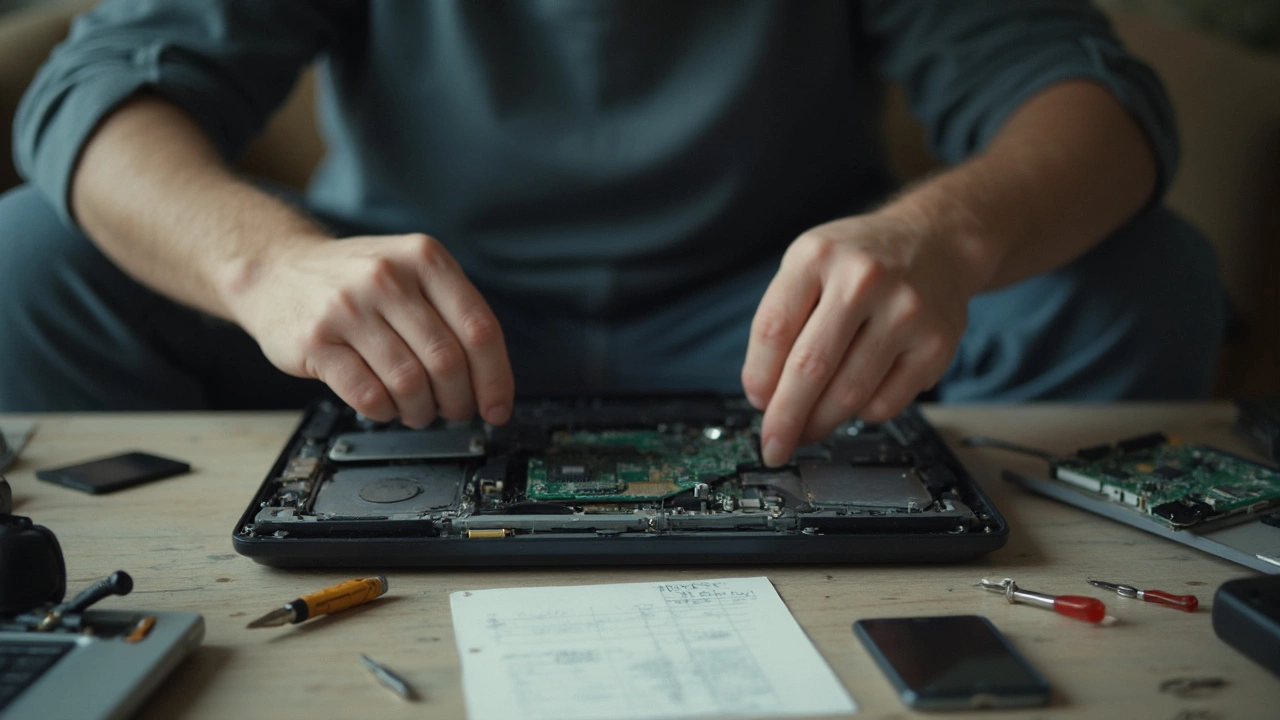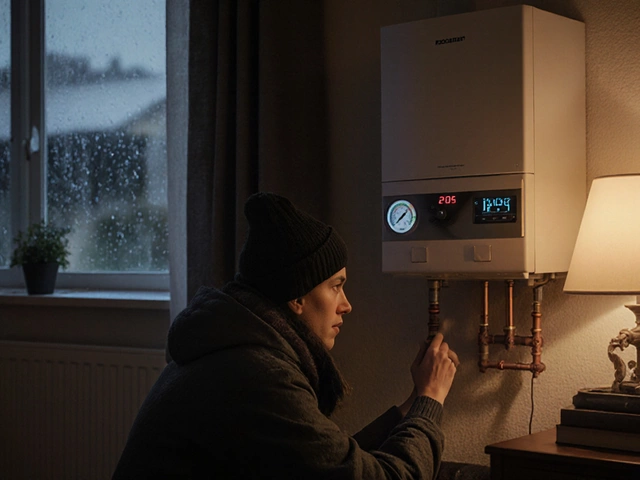Repair shops love to say they can “breathe new life” into any laptop—but when your machine is 7 years old, is that just wishful thinking? At this age, laptops start showing their age fast. Slow boot-ups, random shutdowns, that overheating fan running like a jet engine—it’s almost a rite of passage. But throwing cash at fixes isn’t always smart.
The truth? Not every problem means you should start shopping for a new device. Sometimes, a simple fix or minor upgrade can get you a couple more years, saving you hundreds. But sometimes, a repair is just a temporary patch, and you’ll be back in the shop soon. It’s really all about what you use your laptop for, how much repairs cost, and what you’d be getting if you upgrade.
- Does a 7-Year-Old Laptop Still Hold Up?
- Common Repairs and Their Costs
- Upgrades That Make a Difference
- When is It Time to Move On?
Does a 7-Year-Old Laptop Still Hold Up?
Back in 2018, your laptop was probably a solid performer. Fast forward to 2025—it’s a different story. Tech moves quick. Software updates get heavier, web browsers chew through more RAM, and even basic tasks can feel sluggish on old hardware. The real question: does your 7-year-old laptop actually handle what you need today, or are you just frustrated?
Let’s look at where older laptops often struggle:
- Speed: Booting up or launching apps can take way longer, especially with older hard drives (HDDs) instead of SSDs.
- Battery Life: Most batteries lose about 20–40% of their capacity after 3–5 years. On year seven, you’re lucky to get half the run time you had on day one.
- Compatibility: Newer operating systems sometimes drop support for certain CPUs or chips. For example, Windows 11 requires newer TPM and CPU standards. Some 2018 laptops don’t make the cut.
- Security: Older devices might miss out on crucial updates, leaving you stuck on outdated software if your hardware can’t handle the latest version.
- Heat and Noise: Dust and aging fans mean laptops overheat more and sound noisier. If you’re running anything beyond browsing, it can get annoying fast.
Check out how a 7-year-old laptop lines up against new models today:
| Performance Area | 7-Year-Old Laptop | Current Mid-Range Laptop |
|---|---|---|
| Boot Time | 40–90 seconds* | 10–15 seconds (SSD) |
| Battery Life | 1–2 hours | 5–10 hours |
| OS Support | Windows 10 (maybe 11 with workarounds) | Windows 11 easily |
| Web Browsing | Laggy with multiple tabs | Smooth with 15+ tabs |
| Weight/Portability | Heavier (5+ lbs) | Lighter (3–4 lbs) |
*If your old laptop still uses an HDD, those boot times hurt. If it’s got an SSD already, things speed up a lot, but you’ll still see limits elsewhere.
Here’s the thing: if you mostly browse, stream, or do light office stuff, a 7-year-old laptop with a laptop repair or minor upgrade can still serve. But demanding tasks like video editing, gaming, or even heavy multitasking will become a struggle. If work or school depends on it running well every day, you might want to rethink your plan.
Common Repairs and Their Costs
Don't let anyone tell you every fix is cheap—when it comes to a laptop that’s seven years old, repair bills can sneak up fast. Here’s what you’ll probably run into if your machine is acting up, and what you might have to shell out.
- Laptop repair basics: If the battery won’t hold a charge, a replacement usually sits between $40–$120 for most brands. Some newer batteries are built-in, so you might be looking at another $30–$50 for installation. DIY is possible, but not for everyone.
- Screens: Cracked or flickering? Replacing a display on an old laptop usually runs $80–$200. Brands like Apple are pricier. And with labor, the total can almost match a Chromebook’s price.
- Trackpads and keyboards: Spills and stuck keys are super common by year seven. Expect $50–$150 depending on the model and whether parts are still in stock.
- Hard drive failures: For an old spinning HDD, a swap for a basic SSD costs $35–$100, plus $50–$100 for labor. Upgrading gives new life, but figure in time to reinstall your OS and data.
- Fans and overheating: Dusty fans or weak cooling cost around $20–$60 to clean or replace, but if the motherboard gets fried, repairs can run $200+—not worth it on such an old device.
To put numbers to the talk, check out this quick table:
| Repair Type | Average Cost (Parts + Labor) |
|---|---|
| Battery Replacement | $60–$170 |
| Screen Replacement | $120–$250 |
| Trackpad/Keyboard | $50–$150 |
| Hard Drive/SSD Upgrade | $85–$200 |
| Fan Replacement | $20–$80 |
| Motherboard Repair | $200+ |
Add up two or more of these jobs, and the total can snowball past $300—just for repairs. No surprise why a lot of people pause and rethink sinking that kind of cash into an older machine.

Upgrades That Make a Difference
Let’s get straight to it—if you’re hoping to squeeze more life out of a 7 year old laptop, focus on what actually moves the needle. Not every upgrade is worth your time or money. But when you pick the right ones, it can feel like you bought a whole new machine. Here’s what works best with older laptops:
- SSD upgrade: Swapping out an old hard drive for a solid-state drive (SSD) is easily the biggest boost for your buck. Laptops sold seven years ago usually came with slow, spinning hard drives. If you replace that with an SSD, you’ll see your boot-up time shrink from minutes to seconds. File transfers, app launches, and even basic browsing get way snappier.
- Add more RAM: Back in 2018, 4GB of RAM was considered normal for a lot of budget laptops. Today, apps need more memory to run smoothly. If your laptop supports it, jumping to 8GB or even 16GB can prevent all that lag and freezing, especially with tons of browser tabs open. Quick tip—Google your laptop’s exact model to check if RAM is upgradable, since some have it soldered to the board and can’t be replaced.
- Fresh battery: If your laptop won’t hold a charge or dies in under an hour, a new battery can make it usable again. After about five years, batteries really start to lose capacity. A lot of older laptops actually use removable batteries, so swapping one out can take minutes.
- Clean out and re-paste: Sometimes, just opening up the case to clear out dust and throwing on new thermal paste can solve overheating and loud fan noise. It won’t make your computer faster, but it’ll stop annoying shutdowns and maybe keep things running longer.
Most folks won’t get much out of upgrading the processor or graphics chip—that’s either impossible or way too expensive on old laptops. And a fresh install of Windows or Chrome OS flex can also make your old laptop feel almost new, especially if you don’t need fancy programs. The bottom line? A couple hundred bucks spent on the right upgrades can turn an old clunker into a totally useable machine, especially if you only use it for browsing, email, and streaming.
When is It Time to Move On?
Sometimes, no matter how much you love your old laptop, fixing it just doesn’t make sense. If you’re pouring money into repairs every few months or struggling to run basic apps, it might be time to let go.
- Laptop repair can cost way more than the device is worth. If your mainboard or screen fails, the bill can hit $200 or more. At that point, you’re near the price of an entry-level new machine.
- Security is a biggie. Older laptops often don’t support the latest Windows or MacOS versions. Without updates, you’re open to viruses and hacks. For example, Windows 10 support is set to end in October 2025, leaving lots of old laptops in the dust.
- Battery life drops off a cliff after years. New batteries cost $50 to $150 for most brands, but some older models are tough to find—or not worth replacing if other parts are failing.
- Performance matters. If it takes more than three minutes to boot or you’re stuck watching spinning wheels on simple tasks, productivity tanks. You can’t force modern speed out of old parts forever.
Check out this quick table with rough numbers on common repair costs. If your repair bill is more than half the price of a similar new device, it’s usually smarter to upgrade.
| Repair | Typical Cost (USD) |
|---|---|
| Screen Replacement | $100–$250 |
| Motherboard Repair | $150–$400 |
| Battery Replacement | $50–$150 |
| SSD Upgrade | $70–$200 |
| Keyboard Replacement | $80–$150 |
If you’re only using your laptop for light web browsing or emails, a little lag might be fine. But if you need reliable video calls, photo editing, or just want everything to work smoothly, that’s a whole different level. You’ll probably notice newer apps won’t run, or your browser nags you about updates your system can’t handle.
Ask yourself: Do I really need to keep dealing with random shutdowns, slow speeds, dodgy wifi, and mounting repair costs? Usually, when repairs start to add up, or you can’t get security updates, that’s the sign it’s time to move on and get something newer and more dependable.





